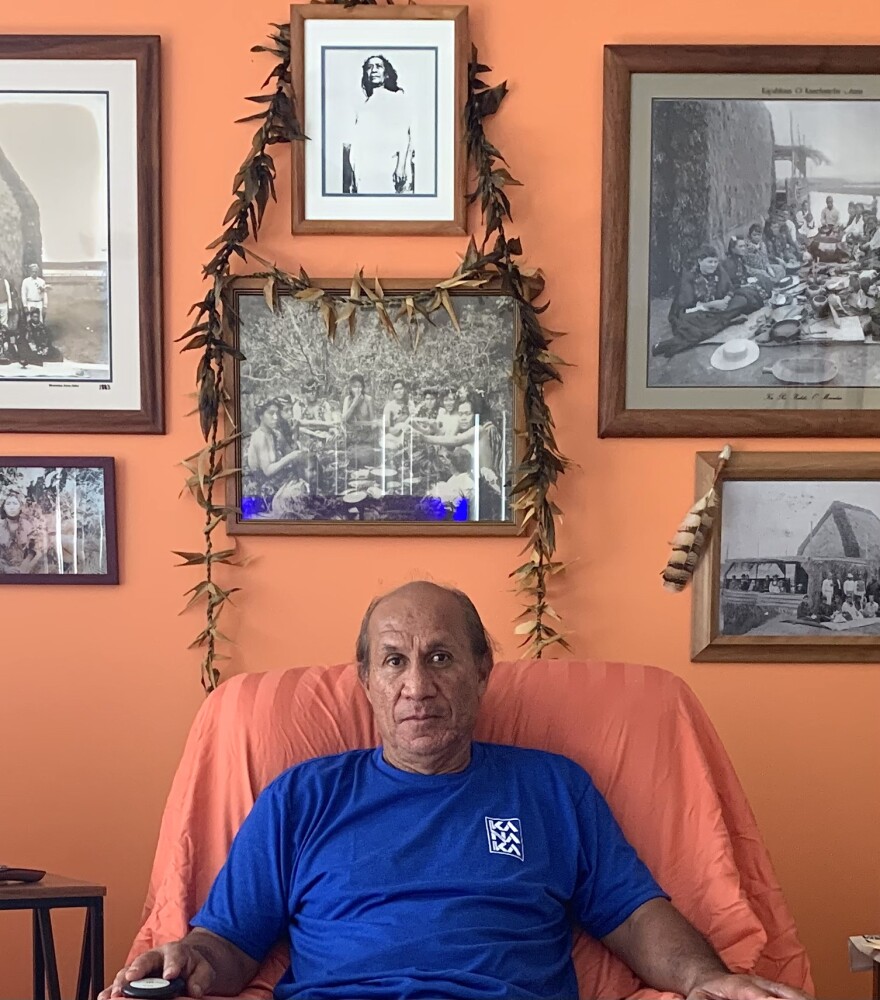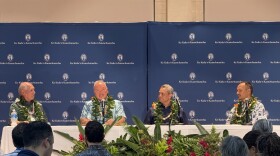As the Navy proceeds with operations to remove the fuel from its Red Hill storage tanks, the larger question remains about where that fuel can be stored. In 2015, Kahu Roddy Akau, the konohiki, or steward, of Moanalua, wrote a widely publicized editorial warning about dangers posed by the fuel tanks. HPR spoke with Akau about the historical and cultural significance of the Red Hill area.
Kahu "Roddy" Kamawaelualani Kawehi Akau's family has been involved with the health and well-being of the Moanalua ahupuaʻa for generations. An ahupuaʻa is the Hawaiian term for a land parcel usually extending from the mountains to the sea.
Akau's responsibility as konohiki, or steward, is to pay attention to everything about the area — clouds, winds, rains, animals, plants and more. He says, in the 13th century, the ruler Maʻilikūkahi made the most of Moanalua's natural attributes.
"Everything was abundant," says Akau. "There was no human sacrifice, no wars. He replenished the whole island of Oʻahu and he built the ahupuaʻa of Moanalua. That's why this is the most exalted place in Moanalua, the Hill of Maʻilikūkahi."
We were poring over a hand-drawn map of the valley. On the left side, the ʻEwa side of Moanalua borders military land where the Navy's 20 jet fuel tanks are lodged in the valley wall, facing west. Akau says the high point in the area now called Red Hill was a key vantage point.
"Kings, chiefs used to come from Maui trying to invade Oʻahu," recounts Akau. "They got pushed back many generations. Then when Kahekili came, he came and slaughtered everybody. That was the first wave."
"Then Kamehameha came, that was the second wave, and this was their seat, up here. In Kamehameha's time, this place was known as the Hill of Strangulation. What's up there today? Tripler Army Hospital. Some crazy things going up there today."
"Mokapu Marine Base, Mokapu, more forbidden." Akau continues, ticking off the Hawaiian names for the area. "Kapukaki, Red Hill, look at all the kapu words. It's not there for nothing. It tells you a lot. You better pay attention."

In 2008, 3,716 acres in Moanalua valley were purchased by the state with help from the Trust for Public Land. Five distinct forest types stretch back to the Koʻolau mountains, with pools, and wildlife.
The endangered ʻelepaio songbird, the guardian spirit for canoe makers is found in the valley. There is a heiau, and unique petroglyphs of winged warriors in the valley, which has two tributaries. Kamanaiki is the smaller section of the valley on the east side, Kamananui is the larger section to the west all the way up to the Koʻolau.
"Kamananui Valley was one of the valleys for the sacred births of chiefs," says Akau. "You hear about the Kings, but it was the women, the Queens, they were the big dogs. The King cannot do without the Queen."
"When they prepared them here," Akau continues. "They were lifted off the ground. They couldn't touch the ground. They had to carry them because they were kapu. All the way, they went to Waimalu, Waiʻawa, all the way down, right to Kukaniloko for the sacred births."
Kahu Roddy Akau points to severe damage sustained on the makai, or ocean end of the Moanalua ahupuaʻa. First, in preparation for a seaplane landing strip, then for the current airport reef runway. In 2009 a Navy battleship somehow ran aground on the reef.
"The anchor in each link chain was 1,200 pounds," Akau says, "They had to throw that off the tugboats high tide, trying to pull 'em off the reef. They damaged couple acres of coral reef. All burial."

Akau says Moanalua people had strong ties to the sea and nearby fisheries. He says the ocean lapped much further inland in the old days, through the Mapunapuna area which floods today during king tides.
"A lot of people came from the Mano House, the Shark House. That was their ʻaumakua (family god.) A lot of them had marks on their bodies, rough skin. My cousins, they all had the mouth, the birthmarks. A lot of people had them. And a lot of the babies. They're all buried under the reef. There was a graveyard under there. That got all ripped off."
Legends say a goddess from afar came to the islands searching for freshwater. She discovered the sacred waters that flow deep in Moanalua Valley. Wai means water. Ola is life.
"Here this Waiola," says Akau. "It's a semi-divine being, this Waiola. It's a spiritual being. There's an underworld underneath here. There's other beings, too. Not only us!"
According to Akau, water has spirit, earth, rocks and trees, everything has spirit. Humans, he says, need to act with that recognition.
Akau cautions, "I'm very afraid for a lot of what's going on. People don't have the right instructions for how to live on earth. Like now, there's a lot of people, native cultures in the world, who have the instructions but who's going to listen to them? The Amazon Indians, the Amazon forest?"
Asked what he would like to see happen in the Moanalua area, Akau responds.
"There's nothing to see. It's a day-to-day thing. I don't like to dream and hope, I'm done with hoping. Everybody wants an answer. I have no answer."
In 2015, Kahu Akau called for the permanent relocation of the Navy's fuel storage tanks on Red Hill, saying they pose a danger to historical, cultural and environmental treasures.
Moanalua Valley is now managed by the State Department of Land and Natural Resources for the benefit of the public. It is open for hiking, hunting, education and enjoyment.
Moanalua Gardens, at the mouth of the valley, was long the home of Hawaiʻi's most picturesque hula celebration, the Prince Lot Hula Festival.
According to Pauline Worsham, managing director for the Moanalua Gardens Foundation, JP Damon currently owns the stately Gardens. Moanalua Gardens Foundation is a separate entity. Presently, there is no connection with the property.
Currently, the Foundation is developing a Management Plan for Kamananui (Moanalua) and Kamanaiki Valleys in the Moanalua Forest Preserve in conjunction with DLNR’s Division of Forestry and Wildlife.
Worsham says the plan will provide a vision, direction and road map for the protection, preservation of the area's storied places for future generations.






